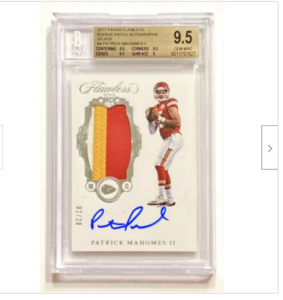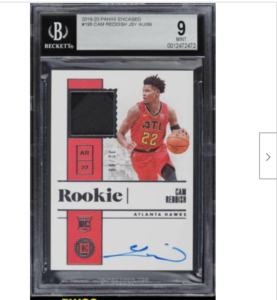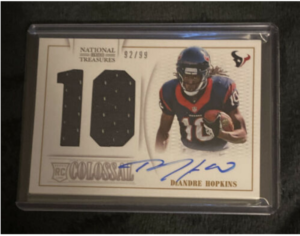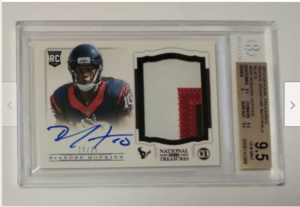All data below was derived from CardLadder, a data analytics tool that vets sales data to provide accurate sales histories of sports cards. All pictures are properly sourced from the buying and selling platform, eBay. Special consideration should be given to Instagram user, Spinotron, whose detailed posts provide a lot of historical details regarding featured cards in this article.
I am not a financial advisor and this is not intended to be financial advice. I do not own any of the cards referenced in this article.
Finding sports cards that will appreciate and sustain their value over a long period of time is no easy task in the modern hobby.
Participants have finally woken up to acquiring the cards of proven, iconic athletes with relatively low populations, and in the process, prices have risen dramatically.
Even though many cards have come down from early 2021 highs, the average price of a sports card is still significantly more than it was 2 years ago, making it harder and harder for people to find and curate a collection of cards that are likely to hold their value over a long period of time.
With prices what they are today, how can you navigate the market and find desirable cards?
The common advice is to seek out low population cards. Card population is the count of a particular card in its assigned grade. In the case of Kobe Bryant’s 1996 Topps Chrome PSA 10 rookie card, there are 830 copies assigned a grade of 10.
While it may feel like all cards have been discovered and appreciated blazingly fast, this is simply not the case.
It’s just harder to find cards with desirable attributes that haven’t experienced the same appreciation.
To develop an instinct for nuanced desirability, you have to find key signals that make a card unique, including, but not limited to:
- Cards with serial numbers that match a player’s jersey number
- Cards that are part of popular and iconic sets
- “First” cards – first year of autographs, first year of a patch, first year of a set
- Card design and aesthetics
- Autograph style, completeness, and color
There are many other attributes to cards that make them desirable, and while some are subjective, many collectors I’ve spoken with value these various aspects.
They see themselves as historians of the hobby and are analytical curators of their collections.
They pair data (population data and price trends) with the history and elements of a particular card that makes it unique to them and their collection.
Jersey Number Cards
First up are cards with serial numbers that match a player’s jersey number.
Serial numbers indicate the print run (number of copies) of a card issued. You may find a card that is numbered 11/99, for example. This means it’s the 11th copy of the 99 available cards of that style, color, type, and year.
While many modern cards have serial-numbered parallels, this doesn’t guarantee scarcity. You may have similar-looking parallels numbered to /99, /199, and /299 that don’t make as much difference in the demand for that card.
For example, there are 23 serial numbered parallels (apart from two 1/1 parallels) in the 2018 Prizm Basketball set.
That means there are over 1,000 serial-numbered Luka Doncic Prizm rookie cards printed, but only 7 would be serial-numbered to Doncic’s playing number, 77.
Because Doncic has such a high-jersey number, most parallels with shorter print runs don’t have the opportunity to be numbered 77 or higher.
Ultimately, the market dictates what is popular, but given the opportunity, I would look to find cards serial-numbered with a jersey number.
This can be applied to non-rookie cards as well. There will only be so many that feature a player’s jersey number in the serial stamp, and if I’m trying to protect the value of my collection, it’s a card feature I would consider because it makes it unique.
As demand for sports and trading cards increases, I believe buyers will look to new ways to find scarcity in their cards. Collecting jersey-numbered cards is nuanced, which means there might not be as much competition to find these cards.
Pro-Tip: You may look for cards that come from an MVP season or championship year of a player. Non-rookie cards haven’t historically commanded high prices, but in this market, that is changing.
Popular sets
The 2003 Topps Chrome basketball set has grown in popularity recently and not just in its rookie cards. Many collectors I’ve spoken with opened those boxes 18 years ago to chase Lebron James, who was hyped coming into the NBA. If you are familiar with Zion-mania and the excitement of opening packs to find one of his cards, it’s not hard to understand why people would pay big money for the 2003 version of the card (especially because Lebron lived up to the hype).
For many, chasing a card (trying to get one in a box they purchased), not getting it, but growing older and having the spending power to go buy it is appealing.
In my two years since rejoining the hobby, there was nothing more fun than opening boxes of cards. Anytime I would buy a box of 2016 Prizm football, I couldn’t get home from work fast enough to open it.
Because of that, I’ve already developed a nostalgia for 2016 Prizm football. It brings me right back to Spring of 2019 and so many positive memories of trying to find Carson Wentz rookie cards.
While opening boxes almost always loses you money, I encourage everyone to find a box they can afford to open. It will help you understand why people have strong connections to certain sets and are willing to pay big sums of money for the cards they wanted to find, but didn’t, in those sets.
We’re also seeing that the rookie card of a certain set can lift the value of other popular player’s cards in that set.
For example, the 2003 Topps Chrome Refractor Kobe Bryant PSA 10 has risen 1,195% in value in just one year. In February of 2020, you could have had this card for $521. Its most recent sale was $6,750.
As both flagship and alternative rookie cards get more expensive, it’s always useful to look at other sets from non-rookie years as a way to find cards you enjoy and that will hold value.
While Kobe Bryant cards have risen across the board, you might consider looking at other popular player’s 1996 Topps Chrome and 2003 Topps Chrome cards as a more affordable alternative.
One advantage (and eventual disadvantage) is that non-rookie cards of popular sets weren’t graded often. There have been 250 total graded 2003 Topps Chrome Kobe Bryant cards versus 5,941 for Lebron James.
Many of those cards weren’t valuable at the time, so people didn’t take the time to grade them, making them more scarce in high grades.
“First Cards” and Hobby History
Set (i.e. Topps Chrome) history is important to the hobby and it’s reflected by the prices paid for cards that might not be obvious at first.
Let’s look at an example:

Source: eBay sold listings
You might look at this card and wonder why a single-color non-rookie BGS 8.5 patch card (even if it is Kobe Bryant) sold for $11,200.
It’s because it is the first ever game-used jersey patch card for Kobe Bryant.
We’re spoiled in the modern hobby because patch cards are now commonplace, but you can imagine the rush of collectors going to buy this product to get their first-ever jersey patch cards.
It’s no surprise that someone would pay a high price tag years later to get this piece of hobby history.
Let’s look at another example to drive this point home:

Source: eBay
This card brings together the two elements I’ve written about so far: it is a jersey number card (24/49) and this particular product has historical significance in the hobby.
I have to give all credit to Instagram user Spinotron for my understanding of the history of this card.
In 2009, it was announced that Panini would become the exclusive trading card partner of the NBA, and this entirely new design (featuring the silhouette of a player overlaid on a large Game Used jersey patch window) caught the attention of collectors in 2011.
Exquisite was the first product to introduce premium patch autographed cards in 2003, but the inaugural Panini Preferred Silhouettes holds special significance as Panini’s first product to challenge the Exquisite brand.
All of the products we know and collect today (at least for modern football and basketball) have some ties to this particular card set, as collectors began to take Panini seriously.
Let’s look at one final example, Contenders Football:

Source: eBay Sold Listings
While the price is eye-popping, the history of this set is what makes it so valuable.
Contenders originally debuted in 1993, but it wasn’t until 1998 that they introduced the Rookie Ticket Autograph cards.
Panini purchased the brand that produced the cards in 2009, ultimately changing its name from Playoff to Panini Contenders in 2012.
If you’re savvy, you will realize that Contenders Rookie Auto Tickets have been popular for over 20 years and that if you’re looking to find a card that will hold its value, it’s a good place to start in football.
In a market where card companies are producing new products and increasing print-runs to satisfy demand, you can protect yourself with products that have been popular for decades instead of a flash in the pan that’s popular for a year.
The lesson here is not that you need to become an expert hobby historian, but that you should consider the depth of hobby history as a tool for building your collection.
It’s these tools that will help you see opportunities and value before others, as most people won’t take the time to get to this level of detail.
Pro Tip: Set checklists can be a valuable research tool. For example, open Google, type in “2018 Panini Contenders Football Checklist”. This will tell you all of the cards contained in the set, and the players in that set. Sometimes, these checklists will identify and show variations as well as print runs of certain cards.
Very few people I know use these checklists to educate themselves – give yourself an advantage by making it a habit to review checklists.
Card Design and Aesthetics
As we saw with the above Kobe Bryant Silhouette Patch Auto, design elements matter significantly in the popularity of a card. In that card’s case, offering the largest game-used patch window in a vertical format with a bright blue autograph appealed to many collectors.
There are a few elements of card design to consider, but the fun part about building a collection that’s unique to you is that you can imprint yourself and your preferences on aesthetic design:
- Is the card vertical or horizontal?
- Are there variations of the card? If so, how rare are those variations?
- Does it feature an action shot or a memorable moment in a player’s career?
- Is the player featured in a particular jersey color or rare uniform variation?
- Are there foil or refractor elements in the card?
- Is the design simple or complex?
- Is there a patch window? What is the shape of that window?
- Does the style of the product contain similarities to other popular products?
These are just a few of the many questions a collector may ask him or herself before making a card purchase. They are curators of the cards they own, and that’s ultimately why many of them have done well purchasing cards that have held value over time.
If you’re building on the advice in this article, you’ll look for card designs and sets that have remained popular over long periods of time.
One of those sets is Topps Chrome.
And there’s a particular later-year, horizontal card, that features what’s now become an iconic player-card image:

Source: eBay Sold Listings
Lebron James guarding Kobe Bryant.
In March of 2020, I purchased this card raw (meaning it had not been encased and graded by a grading company) for just $450. After grading and receiving a 10, I decided to sell at $6,000 (it was the best decision for me at the time).
Before I sold it, I had a feeling that if demand for sports cards generally grew, the card would appreciate significantly. While that happened a lot faster than I imagined, it goes to show that aesthetics can drive up the value of a card.
In this case, the featured player image drove the value.
As prices rise on various cards, start thinking more deeply about aesthetics as it can open your eyes to desirable cards that may not yet have been discovered.
We’ll look at one last example, a card that I’m particularly fond of and hope to one day own:

Source: eBay Sold Listings
At first glance, a BGS 8.5 with single-color jersey patch windows might not seem like an immediately eye-popping card.
However, when you look deeper at this card, an RPA “Rookie Patch Autograph” there are a few notable things about it:
- It is a vertically-formatted card (collectors tend to prefer this)
- The patch windows are shaped into Mahomes’ jersey number – this is similar to other popular sets like Exquisite Numbers
- There were only 15 copies of this card made, with no parallels, making it rarer than the standard /99 rookie patch auto (which sells for significantly more money)
- There are dark red and white design elements that make this unique compared to other vertical rookie patch autographs. See below for a comparison to the Patrick Mahomes Flawless rookie patch auto:
 Source: eBay Listings
Source: eBay Listings
This card has a bold blue autograph, which will be discussed more in the next section, but the patch window (multi-colored) is a more standard shape than most patch cards.
Personal preference may dictate which direction the money flows (this Flawless RPA would likely sell for much more than $12,000) but it goes to show that there are still underappreciated cards in the hobby.
No Immaculate Number RPAs have sold since Mahomes won the Super Bowl last year except the one pictured above, signaling a high level of collectability.
Until January, this is a card I didn’t know existed.
The large majority of people haven’t gone this deep yet and that is because the hobby is so vast. It will only serve you well to delve deeper into cards to understand what is unique and begin to form your own opinions about the aesthetic of a card.
Autograph Style, Completeness, and Color
All autographs aren’t created equally, and it matters when curating your collection.
Some players didn’t sign often during their careers (Tim Duncan), other players are unable to sign new products (Lebron James) and yet others frequently sign new products and have a wide variety of autograph cards available (Kareem Abdul-Jabbar).
Modern players are also signing so much, that their autographs end up looking something like this:

Source: eBay
Some autographs are in bold blue pens, others in black, pink, or gold.
Some autographs are “on-card”, meaning the player physically signed it, while others are “sticker” autographs, where players sign sheets of stickers that are later attached to a card.
I, and I know others, personally prefer on-card autographs. There’s something about a player having a card in hand at one point that connects you to them.
For example, any “on-card” auto by Lebron James, was once held by the man himself. How cool is that?
On-card autographs are cool, but sometimes they get smudged, or the pen ink is faint. This can hurt the long-term desirability of the card.
Let’s compare two cards to better illustrate what this means visually.
Deandre Hopkins, a dominant NFL wide receiver, does not have many “10-grade” autos on his National Treasure Rookie Patch Auto cards. While the below picture is a parallel (a variation in design from the main Rookie Patch Auto), you can see how the autograph is streaky and faded:

Source: eBay
Now let’s look at a cleaner autograph that was graded a “10”:

Source: eBay
The autograph is bright blue, doesn’t feature any streaks, and even includes the jersey number as part of the signature.
This card also happens to be serial numbered “10” out of 25, a jersey number, it is in a high grade, and uniquely features a clean autograph that some of the other copies do not have.
If you are considering an autographed card, make sure it is on-card, make sure it isn’t smudged or streaky, and do some homework on how often a player signs.
Putting it all together
The hobby isn’t as simple as buying Prizm Silvers or Topps Chrome Refractors anymore. It’s gotten competitive to curate a collection that will hold value over the long term, but it’s not impossible.
While I’ve attempted to be as detailed as possible in this article, there are plenty of other strategies and frameworks to find unique cards.
You have to find what works for you, but you have to understand that it takes time to get the education to know what is rare, unique, and desirable.
So many people I personally know are reading recommendations and buying cards without thinking.
I want to help you understand the why behind appreciation beyond an avalanche of demand. These tips should give you plenty to get started and advance your understanding of the hobby.